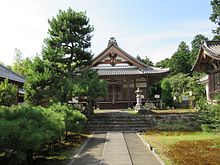Ryūō-ji
The Ryūō-ji ( Japanese 龍王 寺 ) is a temple of the Tendai direction of Buddhism in Ryūō in Shiga Prefecture . It lies at the foot of the Yukino-yama.
history
The temple is a successor to the Yukino-dera ( 雪野 寺 ) built in the Nara period . It is still called Yukino-dera or simply No-dera today. The temple was destroyed in 1446 by soldiers of the Sasaki Tokitsuna ( 佐 々 木 時 綱 ) and only rebuilt on a modest scale in the 17th century.
The temple is famous for its healing effects on asthma and is therefore also called Zensoku-dera ( 喘息 寺 ) or because of the healing power of the sponge gourd , Japanese hechima , also called Hechima-dera ( 糸 瓜 寺 ). Every year in the middle of autumn there is a healing ceremony that is attended by numerous pilgrims.
Treasures of the temple
The temple bell ( 梵 鐘 Bonshō ) comes from the Kamakura period and is registered as an important cultural asset . In the area around the temple, the bell is also known as the "Nodera bell". - Inside the bell frame, song texts are inscribed on all four sides, including a text by Fujiwara no Teika : "Yesterday under flowers: when dawn came, you could hear the voice of the bell of Nodera."
A legend has been passed down in connection with this bell. The general Ono no Tokikane ( 小野 時 兼 ; 1153–1213) living in this area was engaged to a pretty girl. But the girl was the ruler of the Hiragi swamp ( 平 木 ) near the city of Yōkaichi ( 八日 市 , today: Higashiōmi ). She disappeared inside, but left a treasure chest. When Tokigane went to look for her, the girl suddenly appeared in the form of a large snake. Tokikane was startled and hurriedly returned home with the treasure chest. At home he found a bell in the box that he gave to the temple. Even today the bell hanger - ( 竜Ry , Ryūzu ), d. H. "Dragon head" - wrapped in a white cloth and thus remains hidden from the human eye.
The cult figure in the main hall, a seated yakushi , who is one of the temple's hidden treasures, is only shown publicly on August 15, based on the lunar calendar, namely during the Hechima no kaji ( 糸 瓜 の 加 持 ). To the right and left of the altar are the twelve heavenly generals , like the bell, an important cultural asset. They come from the Kamakura period, are made of wood and have glass eyes. They are brightly painted and, somewhat unusually, carry the respective animals of the twelve earth branches on their heads .
literature
- Shiga-ken kotogakko rekishisampo kekkyukai (Ed.): Ryuo-ji . In: Shiga-ken no rekishi sampo (jo) . Yamakawa Shuppan, 1990, ISBN 978-4-634-29250-5 .
Web links
Coordinates: 35 ° 4 ′ 20.3 " N , 136 ° 8 ′ 36.3" E
